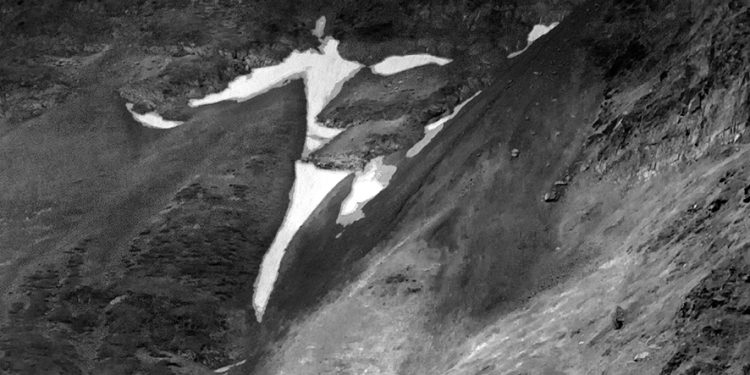Last week, I wrote about an overnight stay in Kutaisi, Georgia’s 5000 year old second city, to pick up some guests and deliver them to our house in the mountains. There was some hard rain as I descended from Etseri to Jvari and towards Zugdidi, overflowing the drainage channels onto the road in the flatlands, and occasionally bursting through the night’s quiet in the city too.
But that rain in west Georgia’s lowlands became snow on the tops of the mountain wall opposite Etseri, as the next day revealed. In early September?! Indeed.
It wasn’t until the morning of that next day, though, taking photos of the unexpected boon of a change in weather and landscape, that I saw what was looking back at me when I examined the mountain wall. What, or who.
Next to the position of the now-melted Dancer, whom I gave his own story in Georgia Today a long while ago, the light snow on the Wall had picked out the face of a huge skull: eye sockets, nose hole, and ghastly grin. I took my shot, and now I can hardly look away. The raw digital file proves what I saw; all I did was crop it and strengthen the contrast. There is Death, in all his awful finality. He takes up about 1/3 of the cropped image’s height and width, and is looking to the upper left corner of the frame. He was destined not to last for more than some hours or days, forming from light early snow which would melt quickly.
I don’t choose what comes to me; I just see it, and take photos. Sometimes the subject is a happy or beautiful one; other times, one to wring the heart and bring dread. “Death” is hardly something which most people would choose to hang on their wall, but I admit to being fascinated by this image, as well as noticing its grimace and horror.
![]()
I had to add Death to the story of the Dancer, because the ending of that story branches. One direction has the Dancer avalanche down and killing the four young men who assail him with shovels to try to improve the fortune of Etseri for the coming year. (The inhabitants of Etseri really used to do this, leaving his one leg pointing right at the village). There is much weeping and wailing at the loss of the village’s brave but foolish youths; and a common funeral for all of them together.
The other ending sees the Dancer relent and only wound the young men, to teach them a lesson, which after several more years of attempts, they get. They survive. But the Dancer had been planning to kill them.
It is Death who actually carries out endings in our world and my written one, who persuades the Denver not to go down that path of no return. The villagers’ revenge for the youths’ deaths might just be to attack his very underlying land with their shovels, not just his snow-based form. This would change the topology which makes him form each midsummer, and prevent him from re-forming at all ever again. He, who has reappeared every July for centuries and could expect as long a life ahead of him, would suddenly be gone for good.
So, listening to his grim counsellor, he pulls back a little, releasing bruising hurt instead of giving the youths into Death’s hands, sparing the village from life-changing bitterness.
I am realizing more and more that my photographically-based Svaneti fantasy stories may continue to grow and get richer as more details emerge and find their way through my camera lenses. Another question I have is: do those who see the images in the stories simply discover what is there for those with vision and wonder? Or does their capacity for such sight draw, or even cause, the images, with all their underlying physical realities of water vapor or geology? This, too, I will try to answer.
In the meantime, I gasp at what comes to my own eyes, sometimes beautiful, sometimes inspiring awe or even terror, record it, and seek a place for it in the mythology I am writing. Do I ever wish I didn’t have this gift?
Never.
Blog By Tony Hanmer
Tony Hanmer has lived in Georgia since 1999, in Svaneti since 2007, and been a weekly writer and photographer for GT since early 2011. He runs the “Svaneti Renaissance” Facebook group, now with over 2000 members, at www.facebook.com/groups/SvanetiRenaissance/
He and his wife also run their own guest house in Etseri: www.facebook.com/hanmer.house.svaneti














